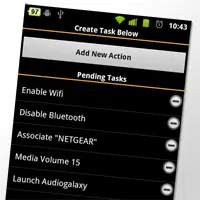The Android app enables a list of instructions to be stored in an NFC tag so that users can simply touch their NFC phone to the tag to initiate a series of events such as putting the handset into ‘car mode’ or connecting to a wireless network — all without needing to make an online connection.

Software developer Joshua Krohn has built an Android app that enables multiple instructions to be stored in an NFC tag and then automatically executed on the handset when the tag is read.
“Instead of only having the options to do things like launch a URL, call a number, open a map to a location or launch a single application, users can now create tags that perform a larger number of actions and can accomplish tasks that are currently not available in these types of applications like interacting with the hardware of the device or changing aspects of the configuration,” Krohn told NFC World.
“You could have a tag that enables Wi-Fi, configures your wireless network and then connects — so visitors would never have to enter your security key to use your wireless connection. They would not need to have an open network, they would only need to scan the tag and the rest is done for them.”
Krohn has used the app to program a number of tags so that they can be used to switch his phone into the correct mode for particular locations; one for his car, one for his office and one for his laptop. “This way when I come to these locations I can hit the tags and essentially have the phone set up how I’d like for that location,” he explains.
In Krohn’s car, for instance, touching the phone to the tag on the dashboard tells the handset to enable Bluetooth, disable Wi-Fi, set the media volume to maximum and launch the Car Home app.
The office tag, meanwhile, enables Wi-Fi, disables Bluetooth, and configures and connects to Krohn’s secure network. And, on his laptop, a tag configures wireless tethering with his choice of access point name and security key and then initiates the tethering.
“The application itself allows me to easily define the tasks to be performed when the tag is read and then write that command string to the tag itself,” says Krohn. “Subsequent reads on the tag will then perform the described actions automatically.”
“It also allows multiple users to use the same tag to perform the same tasks — it’s not tied to any account or service. So, one tag in a public locations could perform the same task for many users.”
How the NFC Task Launcher works
“Essentially what I’ve done is written a simple parser that takes the contents of the tag, breaks it down and executes the described commands. There’s also an interface to create the command strings and write to the tags,” Krohn explains. “I’ve labelled these ‘Task’ tags in my application.
“The current applications that do this type of thing usually require a call back to their own servers to resolve the action described to a specific task to be performed, are limited to one task, and are quite limited in what they can do. As I’ve included the command creation as well as the parser in the application there is no need to sign up for an account with any service or make a network request to find out what the action to be performed it. It is all done locally on the device. All you need is the application installed.
“By creating a parser and command syntax that is succinct I’ve allowed users to build their own custom tags containing multiple commands to be executed while not taking up much space on an individual tag. I tried to develop with tags as small as 64bytes in mind.
“It also allowed me to expand on the functionality a great deal (as much as the Android API allows) to allow users to use NFC technology to perform many more tasks than what are currently offered by the applications that try to do this type of thing.
“As an avid Android user this was my first foray into development for Android and I found the SDK to be quite nice to work with,” Krohn concludes.
NFC Task Launcher is hosted on the XDA Developers forum, where on-going development of the app is taking place. It is also available to download from Android Market as a paid app.
Next: Visit the NFCW Expo to find new suppliers and solutions
good idea, you can configure you mobile phone as you want by this application.
Hi,
I watched your videos on youtube…very, very nice! I have one question – can the tags that are created through your app be read only? If not, how can you prevent someone from overwriting a tag that you create with their own. I.E. if a marketer used your app to create a tag could a passer-by change it?